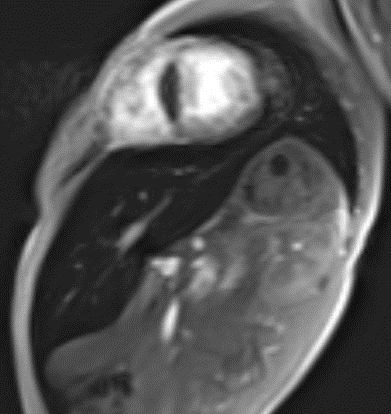
Contributions
Abstract: PB2194
Type: Publication Only
Background
Magnetic resonance imaging (MRI) assessment of liver iron concentration (LIC) is necessary for quantitative staging of iron overload in children with β-Thalassemia. There is no enough evidence about the effect of spirulina therapy on LIC.
Aims
To assess LIC by MRI in multitransfused β-Thalassemic children infected with HCV before and after Spirulina Therapy.
Methods
Thirty multi-transfused β-thalassemic children infected with HCV, were subjected to clinical evaluation, appropriate laboratory investigations and assessment of LIC by MRI. They were classified according to LIC into mild (group 1) and moderate to severe group (group 2). In addition to standard packed red cell transfusion, Spirulina therapy was given orally for 3 months, after which re-evaluation of these children was performed by repeating the same investigations.
Results
There was significant increase in LIC associated with significant changes in other MRI parameters (significant decrease in T2* and significant increase in R2*) in patients with β-Thalassemia of moderate to severe group as compared to those of the mild group before treatment. The mean values of serum ferritin (SF) was statistically insignificantly higher among patients of mild group. There was no significant correlation between different MRI parameters and SF level. There was negative correlations between LIC and T2* and positive correlation between LIC and R2*. There was significant decrease in values of LIC accompanied with significant improvements in SF after spirulina therapy as compared to their pretreatment values in patients of the moderate to severe group.

Conclusion
Session topic: 26. Thalassemias
Keyword(s): Thalassemia, MRI, iron overload, Childhood
Abstract: PB2194
Type: Publication Only
Background
Magnetic resonance imaging (MRI) assessment of liver iron concentration (LIC) is necessary for quantitative staging of iron overload in children with β-Thalassemia. There is no enough evidence about the effect of spirulina therapy on LIC.
Aims
To assess LIC by MRI in multitransfused β-Thalassemic children infected with HCV before and after Spirulina Therapy.
Methods
Thirty multi-transfused β-thalassemic children infected with HCV, were subjected to clinical evaluation, appropriate laboratory investigations and assessment of LIC by MRI. They were classified according to LIC into mild (group 1) and moderate to severe group (group 2). In addition to standard packed red cell transfusion, Spirulina therapy was given orally for 3 months, after which re-evaluation of these children was performed by repeating the same investigations.
Results
There was significant increase in LIC associated with significant changes in other MRI parameters (significant decrease in T2* and significant increase in R2*) in patients with β-Thalassemia of moderate to severe group as compared to those of the mild group before treatment. The mean values of serum ferritin (SF) was statistically insignificantly higher among patients of mild group. There was no significant correlation between different MRI parameters and SF level. There was negative correlations between LIC and T2* and positive correlation between LIC and R2*. There was significant decrease in values of LIC accompanied with significant improvements in SF after spirulina therapy as compared to their pretreatment values in patients of the moderate to severe group.

Conclusion
Session topic: 26. Thalassemias
Keyword(s): Thalassemia, MRI, iron overload, Childhood


